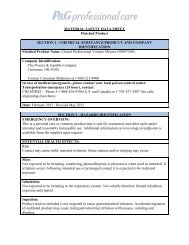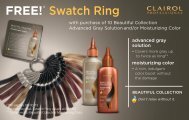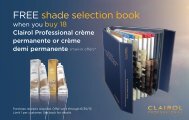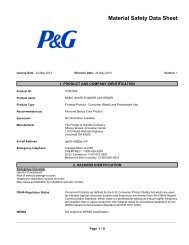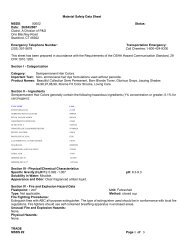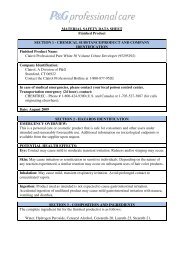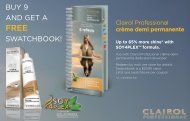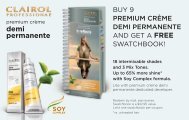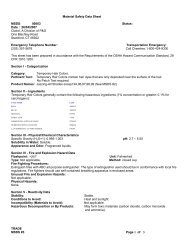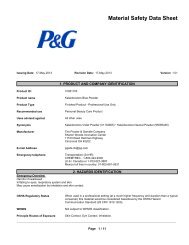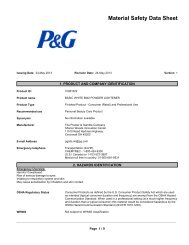Clairol Professional Radiance Color Infuser
Clairol Professional Radiance Color Infuser
Clairol Professional Radiance Color Infuser
- No tags were found...
You also want an ePaper? Increase the reach of your titles
YUMPU automatically turns print PDFs into web optimized ePapers that Google loves.
Section III - Physical/Chemical CharacteristicsSpecific Gravity (H 2 O=1): 0.985-1.192 pH: approximately 3.5Solubility in Water: Complete.Appearance and Odor: Clear-water-thin liquids or viscous creamy white and bluish emulsion. Faint fragrance or no odor.Section IV - Fire and Explosion Hazard DataFlashpoint: Non combustible.Unit: N/AType: Not applicable.Method: Not applicable.Fire Fighting Procedures:Extinguish fires with ABC all-purpose extinguisher. The type of extinguisher used should be in conformance with local fireregulations. Fire fighters should use self contained breathing apparatus in enclosed areas.Unusual Fire and Explosion Hazards:Decomposition, which may be caused by heat or combustion, will release oxygen which will increase the explosive limitrange and burning rate of flammable vapors.Physical Hazards:None.Section V - Reactivity DataStability:Conditions to Avoid:Incompatibility (Materials to Avoid):Hazardous Decomposition or By Products:Unstable.Heat and sunlight.Reducing agents; such as waving lotions; heavy metals and manymany flammables. Do not use metallic bowls or stirrers.Oxygen.Section VI - Health Hazards and Hazard DataThe TLV of the mixture has not been established.1. Effects of Acute Accidental ExposureEye Contact:CAUTION. Developers are eye irritants. May cause severe irritation and possible permanent eye injury.Skin Contact:Prolonged contact with skin may bleach it and cause burns.Inhalation:Not likely to be inhaled.Ingestion:Moderately toxic.2. Effects of Chronic ExposureWhen developers were mixed with hair dyes and applied to the skin of animals for prolonged periods, no adverse effectson growth, reproduction or general health were observed. Prolonged contact with skin may result in bleaching andirritation of skin.Target Organs: Skin.3. Carcinogen Status:OSHA: No NTP: No IARC: No4. Route of Entry:Inhalation: No Ingestion: Yes Skin: Yes5. Pre-existing dermatitis would likely be made worse by exposure to these products.6. Emergency and First Aid ProceduresEye Contact:Remove contact lenses, if used. Flush immediately with plenty of water for 15 minutes. Get medical attentionIMMEDIATELY.Skin Contact:If spilled, wash skin immediately with soap and water (do not use solvents). Change into clean clothing. If irritationdevelops, contact dermatologist.Inhalation:Remove person to fresh air. Increase ventilation.Ingestion:Rinse out mouth with water and administer large amounts of milk. Contact Poison Control Center.TRADEMSDS #4 Page 2 of 3
Section VII - Precautions for Safe Handling and UseSteps to be taken in Case Material is released or Spilled:Contain spill and promptly clean up. Flush with water and wipe with towel or rinse to drain. Floor can be slippery whenwet.Waste Disposal Method:Products covered by this MSDS, in their original form, are considered non-hazardous waste according to RCRA.Additionally, disposal should be in accordance with all applicable Local, State and Federal regulations.Precautions to be Taken in Handling and Storage:Keep in cool place. Avoid contamination. Keep closed when not in use. Store in the original tightly capped containersaway from sunlight, heat, sparks and flame. Do not store any tint, lightener lotion or bleach powder after it has been mixedwith developer; the container may rupture. Never return unused material to original container. Empty containers should berinsed with water before discarding. Keep out of reach of children. Other precautions: Decomposition of hydrogenperoxide may occur with increase in pressure and possible container rupture.Section VIII - Control MeasuresVentilation:Exhaust system ventilation should be adequate to avoid buildup of vapors.Hand Protection:Use impervious gloves to avoid possible skin irritation.Eye Protection:Avoid contact with eyes. Use protective eyewear, if splashing is possible.Other Types of Protection:Not applicable.Respiratory Protection:Avoid inhalation.Work Hygienic Practices:Always follow good hygienic work practices. Avoid all skin, eye, and clothing contact with products. In case of contact,rinse thoroughly with water. Promptly clean up all spills.Section IX - Transportation InformationDOT Class: Not regulated.IMDG: Not regulated.IATA/ICAO: Not regulated.TRADEMSDS #4 Page 3 of 3




